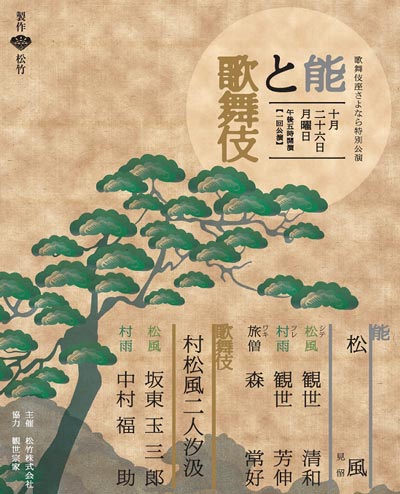| OCTOBER 2009 |
|
2 shows in Nagoya (Misonoza), 4 in T˘ky˘ (Kabukiza, National Theatre), 1 in Fukuoka (Hakataza) and 2 tours (Kinshű Tokubetsu K˘en, Zenshinza)!
|
| Misonoza (Nagoya) |  |
| Dates | 1 ~ 25 October 2009 (Kichirei Kaomise K˘gy˘ Kabuki) |
| MatinÚe |
|
| Evening |
|
| Casting |
Ichikawa Danjűr˘, Kataoka Nizaemon, Kataoka Gat˘, Kataoka Hidetar˘, Nakamura Hashinosuke, Nakamura Fukusuke, Kataoka Ainosuke, Kataoka Takatar˘, Ichikawa Sadanji, Band˘ Yajűr˘, Kataoka Shinnosuke |
| Comments |
The play "Kanadehon Chűshingura" (The Treasure of 47 Loyal Retainers) is the most popular in the Kabuki repertory and is known throughout the world.
|
| Kabukiza (T˘ky˘) |  |
| Dates | 1 ~ 25 October 2009 (Geijutsusai Jűgatsu ďkabuki) Kabukiza Sayonara K˘en |
| MatinÚe | |
| Evening |
|
| Casting |
Onoe Kikugor˘, Band˘ Tamasabur˘, Sakata T˘jűr˘, Nakamura Kichiemon, Band˘ Mitsugor˘, Nakamura Tomijűr˘, Nakamura Tokiz˘, Onoe Kikunosuke, Nakamura Kaishun, Ichikawa Danshir˘, Sawamura Tanosuke, Ichikawa Danz˘, Nakamura Kinnosuke, Band˘ Hikosabur˘, Onoe Sh˘roku, Nakamura Karoku, Nakamura Kash˘, Nakamura T˘z˘, Ichimura Manjir˘, Kawarasaki Gonjűr˘, Band˘ Shűch˘, Nakamura Baigyoku, Nakamura Mantar˘, Band˘ Minosuke, Onoe Matsuya |
| Comments |
10th of the 16 Kabukiza Sayonara K˘en, the Kabukiza Farewell Performances, which will be held up to April 2010.
|
 |
| Kabukiza (T˘ky˘) |  |
| Dates | 26 October 2009 (N˘ to Kabuki) Kabukiza Sayonara Tokubetsu K˘en |
| Program |
Matsukaze Mura no Matsukaze Ninin Shiokumi |
| Casting | |
| Comments |
A special 1-day program called "N˘ and Kabuki", with one N˘ play and one Kabuki dance. The N˘ "Matsukaze" stars Kanze Kiyokazu and Kanze Yoshinobu. The Kabuki dance "Ninin Shiokumi" stars Band˘ Tamasabur˘ and Nakamura Fukusuke in the roles of Matsukaze and Murasame. Source: Earphone Guide website |
 |
| National Theatre (T˘ky˘) |
| Dates | 4 ~ 27 October 2009 |
| Program | |
| Casting | |
| Comments |
There are few writers who have been more popular than Edogawa Rampo (1894-1965). His pen name is based on Edgar Allan Poe and he introduced detective stories to Japan with his super detective Akechi Kogor˘. The writer also was a master of the grotesque and erotic and created characters with strange passions, masquerading as chairs to get close to the beloved, trying to preserve the bodies of beautiful men and women by turning them into perfect looking mannequins. In November 2008 the National Theatre presented "Edo no Yami Ayashi no Kagizume", a new Kabuki play that dramatized one of Edogawa Rampoĺs most haunting and popular novels, "Ningenhy˘" ("The Were-Panther"), about a man who has the lustful and bloodthirsty tastes of an animal and even resembles a panther, with glittering eyes, huge mouth and sharp teeth. He comes to battle the master detective Akechi Kogor˘ and stalks the women that are nearest and dearest to him. But instead of the jazzy atmosphere of the 1920ĺs of the original, the play was transferred to the Edo Period (1603-1868). That play ended with the villain escaping on a giant kite. In October 2009, the National Theatre will present a sequel, that takes the villain into the turbulent days of Ky˘to during the battles that brought the Tokugawa Shogunate to an end. Starring Matsumoto K˘shir˘ as Akechi Kogor˘ and Ichikawa Somegor˘ as the were-panther. |
|
|||
| Dates | 2 ~ 26 October 2009 (Kinshű Hanagata Kabuki) | ||
| Program | |||
| Casting |
Ichikawa Ebiz˘, Nakamura Shibajaku, ďtani Tomoemon, Ichikawa Ukon, Ichikawa Monnosuke, Ichikawa Emisabur˘, Ichikawa Unosuke, Kataoka Ichiz˘, Band˘ Shinsha, Ichikawa Shun'en, Ichikawa En'ya, Sawamura S˘nosuke |
||
| Comments |
T˘shi ky˘gen production of the spectacular drama "Narukami Fud˘ Kitayama Zakura", which includes "Kenuki", "Narukami" and "Fud˘" (which all belong to the Kabuki Jűhachiban). Ichikawa Ebiz˘ plays the roles of Kumedera Danj˘, the wicked priest Narukami, Prince Hayagumo, Abe Kiyoyuki and the Deity Fud˘ My˘˘. The role of Princess Taema is played by Nakamura Shibajaku. |
||
| Kinshű Tokubetsu K˘en | |
| Dates | 8 ~ 24 October 2009 |
| Program |
Shin |
| Casting | |
| Comments |
The first item in this program is a taiko show (led by Hayashi Eitetsu), the second one is a tsugaru jamisen concert (led by Takahashi Chikud˘), the third one is a Kabuki dance and the last one ("Shin") is a new creation mixing all the previous arts (with a choreography done by Fujima Kanjűr˘ VIII and the collaboration of Tanaka Denzaemon XII for the musical accompaniment). |
| Zenshinza Tour | |
| Dates | 1 ~ 31 October 2009 |
| Program | |
| Casting |
Arashi Keishi, Kawarasaki Kunitar˘, Arashi Hironari, Anegawa Shinnosuke, Ikushima Kigor˘, Matsunami Kihachir˘ |
| Comments |
The Zenshinza troupe is on tour all over Japan: Source: Earphone Guide website |
|
|
| Contact | Main | Top | Updates | Actors | Plays | Playwrights | Programs | Links | FAQ | Glossary | Chronology | Illustrations | Prints | Characters | Derivatives | Theaters | Coming soon | News |
